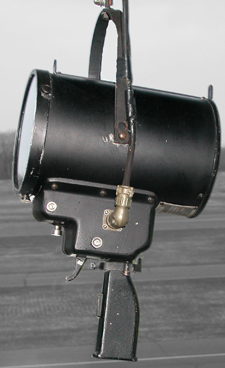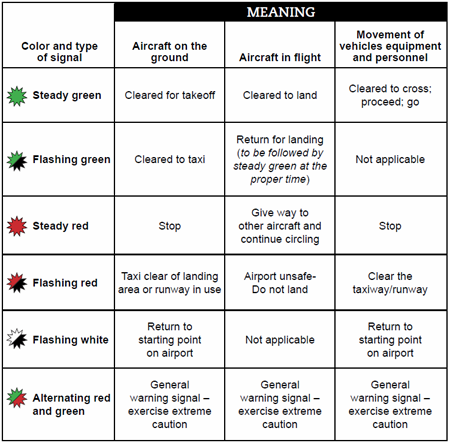Alternating Red & Green – Use Caution! |
|
The alternating red and green signal is issued as a general warning to advise pilots to exercise caution. Here is the written guidance the FAA has provided for controllers in using it. “Direct a general warning signal, alternating red and green, to aircraft or vehicle operators, as appropriate, when: My thought was that it’s more in the vein of giving ideas for its use that are situations that virtually any controller probably would think to advise caution anyway. Then, to this list, the FAA adds the following note: “The warning signal is not a prohibitive signal and can be followed by any other light signal, as circumstances permit.” I was struck by the fact that no other guidance is given for when to use the light gun signals. So, I did the natural thing: I asked controllers. I spoke to pilot friends who also had earned their degrees in air traffic control. In the end, I have concluded that the lack of specificity in guidance for using the other signals is likely due to the variable nature of the situations possible. |
|
The “variable nature of the situations possible”???? |
|
Sure! Think of it like this: Pilots simply are expected to know the meaning of the light gun signals, and after all, so are the controllers. As a pilot, you are responsible to know what is being communicated to you. Since no two airports are the same, and no two emergencies are the same, it’s likely the FAA doesn’t want controllers to be boxed in by limiting the meaning of a light gun signal. Therefore the FAA has not defined how to use the signals, but rather given the signals meanings! In so doing, the FAA has given the controllers the latitude to determine how best to issue light gun signals to accomplish the ultimate purpose of making them available: To resolve a no radio emergency as expeditiously and safely as possible. As proof, consider what you saw (if you followed the above hyperlink) on the front page of Order JO 7110.65T: “This order prescribes air traffic control procedures and phraseology for use by personnel providing air traffic control services. Controllers are required to be familiar with the provisions of this order that pertain to their operational responsibilities and to exercise their best judgment if they encounter situations not covered by it.” Emphasis added Order JO 7110.65T Clearly we see that “when to use a particular light gun signal” isn’t covered, so controllers are going to assess each individual situation to determine which signal is best given the airport, the conditions at the airport, the aircraft that is operating without a radio, etc. All clear now, right? Don’t worry - I didn’t actually think you'd think it was... |
|
Steady Green & Flashing Green – Which is the one you want? |
|
If you are airborne, a steady green light is clearance to land. It’s quite straight forward, indeed. It advises that upon your arrival, the runway will be unoccupied and you have their permission to land on it. However, of more confusion is the “flashing green” signal – it means: “return for landing, to be followed by steady green at the proper time”. |
|
Wow! What would provoke a controller to do that to you? |
|
Imagine this: You’ve had a radio failure, you show up at an airport and receive the coveted steady green light, and yet, you’re too fast on final to safely land. You’d choose to go around (I hope)! The tower controller will observe you initiate the go around and could flash the green light to let you know you’re permitted to remain in the pattern and come around again if it appeared that the pilot seemed uncertain. The controller may even continue the flashing green signal while the aircraft is on the downwind leg until it turns base and it is obvious that the airplane is returning. The controller would then begin to use the steady green light signal to advise you that you are again “cleared to land”. Alternatively, it is completely possible for the controller to also just continue using the steady green to indicate to the pilot that he or she is still, “cleared to land”! See that, the controller will use their judgment! |
|
Steady Red & Flashing Red – You don't really have to leave! |
|
In flight, a flashing red signal means that the airport is unsafe. You are not cleared to land! One person theorized that it could be used to indicate some sort of problem on or with the runway. This “problem” could be a vehicle, animal or debris. Of course as the pilot in command, you could choose to land anyway if you determined that the situation was so dire that it made more sense to land anyway. On the other hand, you, the pilot, may agree with the controller and choose to go around. You may decide to return for landing on the same runway. You may choose to go to another airport if the situation seems bad enough. It will be your decision what to do next as pilot in command. A steady red light gun signal means “Give way to other aircraft and continue circling”. It indicates the involvement of another aircraft and the controller wants you to allow it to precede you to the runway. Now, why this would be desirable is hard to imagine too. After all, an aircraft without a radio is treated as an emergency, and it’s not like the controller is going to try to allow someone to get another touch and go in before you arrive. But, it’s likely that the FAA has included this signal for the sake of allowing a controller to communicate any possible situation, if in their judgment, it is necessary. At any rate, the signal exists, and if you receive a steady read signal, you should expect to follow another aircraft to the runway. At that point, it becomes the pilot’s responsibility to determine how to most safely continue to the runway. You could extend the downwind leg to fall in behind the other aircraft. You could choose to reduce speed and fly a normal pattern. You may even choose to line up with and attempt to land on another runway at that same airport. Remember, it is your, the pilot in command’s, responsibility to always conduct the flight safely! How you accomplish that is likely to be as situational as the light gun signal you receive. |
|
Aircraft response to light gun signals |
|
ATC light gun signals are instructions issues by a controller, and pilots are required to comply with them.
|
|
Article by: Terry Keller Jr. |
|


